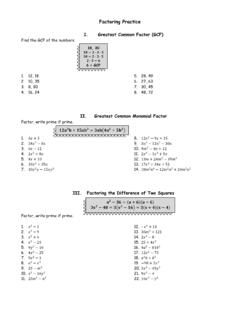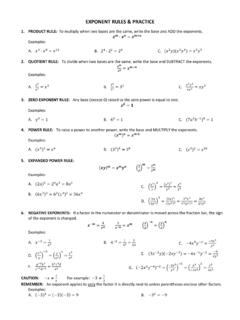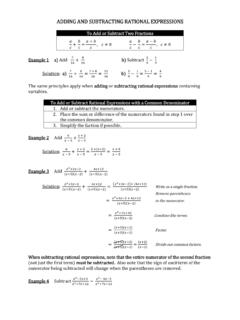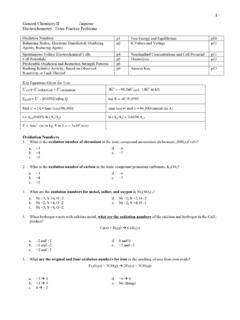Transcription of Reading Comprehension Practice Test
1 Reading Comprehension Practice Test 1. Questions 1-7. In the sixteenth century, an age of great marine and terrestrial exploration, Ferdinand Magellan led the first expedition to sail around the world. As a young Portuguese noble, he served the king of Portugal, but he became involved in the quagmire of political intrigue at court and lost the king's favor. After he was dismissed from service to the king of Portugal, he offered to serve the future Emperor Charles V of Spain. A papal decree of 1493 had assigned all land in the New World west of 50 degrees W longitude to Spain and all the land east of that line to Portugal.
2 Magellan offered to prove that the East Indies fell under Spanish authority. On September 20, 1519, Magellan set sail from Spain with five ships. More than a year later, one of these ships was exploring the topography of South America in search of a water route across the continent. This ship sank, but the remaining four ships searched along the southern peninsula of South America. Finally they found the passage they sought near a latitude of 50 degrees S. Magellan named this passage the Strait of All Saints, but today we know it as the Strait of Magellan.
3 One ship deserted while in this passage and returned to Spain, so fewer sailors were privileged to gaze at that first panorama of the Pacific Ocean. Those who remained crossed the meridian we now call the International Date Line in the early spring of 1521 after ninety-eight days on the Pacific Ocean. During those long days at sea, many of Magellan's men died of starvation and disease. Later Magellan became involved in an insular conflict in the Philippines and was killed in a tribal battle. Only one ship and seventeen sailors under the command of the Basque navigator Elcano survived to complete the westward journey to Spain and thus prove once and for all that the world is round, with no precipice at the edge.
4 The sixteenth century was an age of great ___exploration. A. cosmic B. land C. mental D. common man E. none of the above 2. Magellan lost the favor of the king of Portugal when he became involved in a political ___. A. entanglement B. discussion C. negotiation D. problems E. none of the above 3. The Pope divided New World lands between Spain and Portugal according to their location on one side or the other of an imaginary geographical line 50 degrees west of Greenwich that extends in a ___ direction. A. north and south B. crosswise C.
5 Easterly D. south east E. north and west 4. One of Magellan's ships explored the ___ of South America for a passage across the continent. A. coastline B. mountain range C. physical features D. islands E. none of the above 5. Four of the ships sought a passage along a southern ___. A. coast B. inland C. body of land with water on three sides D. border E. answer not available 6. The passage was found near 50 degrees S of ___. A. Greenwich B. The equator C. Spain D. Portugal E. Madrid 7. In the spring of 1521, the ships crossed the ___ now called the International Date Line.
6 A. imaginary circle passing through the poles B. Imaginary line parallel to the equator C. area D. land mass E. answer not found in article 8. Questions 8-14 Marie Curie was one of the most accomplished scientists in history. Together with her husband, Pierre, she discovered radium, an element widely used for treating cancer, and studied uranium and other radioactive substances. Pierre and Marie's amicable collaboration later helped to unlock the secrets of the atom. Marie was born in 1867 in Warsaw, Poland, where her father was a professor of physics.
7 At the early age, she displayed a brilliant mind and a blithe personality. Her great exuberance for learning prompted her to continue with her studies after high school. She became disgruntled, however, when she learned that the university in Warsaw was closed to women. Determined to receive a higher education, she defiantly left Poland and in 1891 entered the Sorbonne, a French university, where she earned her master's degree and doctorate in physics. Marie was fortunate to have studied at the Sorbonne with some of the greatest scientists of her day, one of whom was Pierre Curie.
8 Marie and Pierre were married in 1895 and spent many productive years working together in the physics laboratory. A short time after they discovered radium, Pierre was killed by a horse-drawn wagon in 1906. Marie was stunned by this horrible misfortune and endured heartbreaking anguish. Despondently she recalled their close relationship and the joy that they had shared in scientific research. The fact that she had two young daughters to raise by herself greatly increased her distress. Curie's feeling of desolation finally began to fade when she was asked to succeed her husband as a physics professor at the Sorbonne.
9 She was the first woman to be given a professorship at the world- famous university. In 1911 she received the Nobel Prize in chemistry for isolating radium. Although Marie Curie eventually suffered a fatal illness from her long exposure to radium, she never became disillusioned about her work. Regardless of the consequences, she had dedicated herself to science and to revealing the mysteries of the physical world. The Curies' ____ collaboration helped to unlock the secrets of the atom. A. friendly B. competitive C. courteous D. industrious E.
10 Chemistry 9. Marie had a bright mind and a __personality. A. strong B. lighthearted C. humorous D. strange E. envious 10. When she learned that she could not attend the university in Warsaw, she felt___. A. hopeless B. annoyed C. depressed D. worried E. none of the above 11. Marie ___ by leaving Poland and traveling to France to enter the Sorbonne. A. challenged authority B. showed intelligence C. behaved D. was distressed E. answer not available in article 12. _____she remembered their joy together. A. Dejectedly B. Worried C.

















